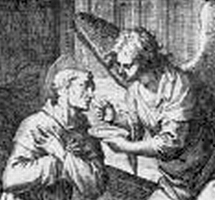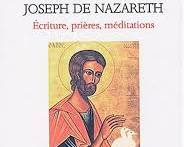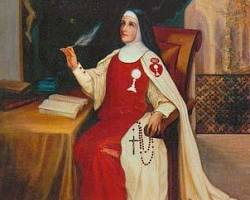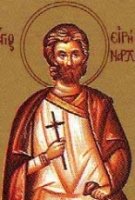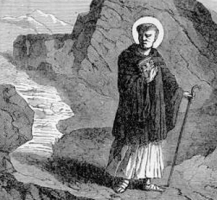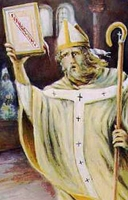Saint Saturninus of Toulouse
டுலூஸ் நகரின் புனிதர் சட்டுர்னின்
கௌல் அப்போஸ்தலர்/ ஆயர்/ மறைசாட்சி:
பிறப்பு: கி.பி. மூன்றாம் நூற்றாண்டு
பெட்ராஸ், கிரேக்கம்
இறப்பு: கி.பி. 257
டுலூஸ், கௌல், (தற்போதைய ஃபிரான்ஸ்)
ஏற்கும் சமயம்:
ரோமன் கத்தோலிக்க திருச்சபை
கிழக்கு மரபுவழி திருச்சபை
நினைவுத் திருநாள்: நவம்பர் 29
பாதுகாவல்:
டுலூஸ், ஃபிரான்ஸ்
புனிதர் சட்டுர்னின், "டுலூஸ்" (Toulouse) பகுதியின் முதல் ஆயரும், பழங்கால ஐரோப்பாவின் பிராந்தியமான "கௌல்" (Gaul) என்னுமிடத்தின் அப்போஸ்தலர்களுள் ஒருவராக மதிக்கப்படுபவரும் ஆவார்.
(இப்பிராந்தியம், தற்கால ஃபிரான்ஸ், பெல்ஜியம், நெதர்லாந்தின் தென் பிராந்தியம், ஜெர்மனியின் தென்மேற்குப் பிராந்தியம் மற்றும் இத்தாலியின் வட பிராந்தியங்களுடன் ஒத்துப்போவதாகும். கி.பி. 222ல், ஆல்ப்ஸ் மலைகளின் தென்பகுதி ரோமானியர்களால் வெற்றி கொள்ளப்பட்டது. அவர்கள் இப்பகுதியை "கிஸால்பின் கௌல்" (Cisalpine Gaul) என்று அழைத்தனர். ஆல்ப்ஸ் மலைகளின் வட பிராந்தியம், "ட்ரான்ஸல்பின் கௌல்" (Transalpine Gaul) என்று அழைக்கப்பட்டது. இப்பிராந்தியம் கி.பி. 58 மற்றும் 51ல் "ஜூலியஸ் சீசரால்" (Julius Caesar) எடுத்துக்கொள்ளப்பட்டது.)
அந்நாளில், கௌல் பிராந்திய பேரரசன் "டெசியஸ்" (Emperor Decius) என்பவன் கிறிஸ்தவ மக்களை துன்புறுத்தினான். அவனால் சிறு அளவிலான கிறிஸ்தவ சமூகத்தினரையே கலைக்க இயன்றது. கி.பி. 236 – 250 காலகட்டத்தில், திருத்தந்தை புனிதர் “ஃபபியானின்” (Pope St. Fabian) வழிகாட்டுதலின்படி கௌல் பிராந்தியத்துக்கு அனுப்பப்பட்ட அப்போஸ்தலர்களுள் புனிதர் சட்டுர்னினும் ஒருவர் ஆவார்.
திருத்தந்தை புனிதர் ஃபபியான் ரோமிலிருந்து ஏழு ஆயர்களை மறைப்பரப்பு பணிக்காக கௌல் பிராந்தியத்துக்கு அனுப்பி வைத்தார்.
புனிதர் சட்டுர்னின் ஓர் சிறந்த மறைபரப்பு பணியாளர் ஆவார். இவர் தமது மறைபரப்பு பணியின்போது பலரை மனந்திருப்பி, திருமுழுக்குக் கொடுத்து பணியாற்றியுள்ளார். நற்செய்தியை பரப்புவதில் கண்ணும் கருத்துமாய் செயல்பட்டுள்ளார். கிறிஸ்துவின் மதிப்பீடுகளுக்கு மிக முக்கியத்துவம் கொடுத்து வாழ்ந்தவர். இதனால் திருத்தந்தை ஃபபியான் இவரை தூலூஸ் நகருக்கு ஆயராக தேர்ந்தெடுத்தார். இவர் தூலூஸ் நகரின் "முதல் ஆயர்" என்ற பெருமைக்குரியவர் ஆவார்.
'பாகன்' என்றழைக்கப்படும் கிறிஸ்துவுக்கு எதிரான மத குருமார், சிலை வழிபாட்டுக்கு எதிரான இவரை கொலை செய்யும் தருணத்துக்காக காத்திருந்தனர். ஒருநாள் இவரைப் பிடித்து மரண தண்டனை அறிவித்தனர். இவரை ஒரு எருதின் கால்களில் கட்டி இழுத்துப் போனார்கள். அந்த எருது, அவரை கட்டப்பட்ட கயிறு அறுந்து போகும்வரை இழுத்துச் சென்றது. "பாம்ப்லோனா" (Pamplona) என்ற இடத்தில் இவர் மறைசாட்சியாக மரித்தார்.
Also known as
Cernín, Sadurní, Sadurninho, Sarnin, Satordi, Saturdi, Saturnin, Saturnino, Serenín, Sernin, Zernin
Additional Memorial
30 October (translation of relics)
Profile
Born to the third century Roman nobility. Missionary to Gaul, the Pyrenees, and the Iberian peninsula. Worked with Saint Papoul. He converted many, including the farmer now known as Saint Honestus who joined him as a missionary. Imprisoned in Carcassone by the prefect Rufinus, Saturninus and his group were freed by an angel. He became the first bishop of Toulouse in modern France), where he teamed with Saint Martial to perform miraculous healings. Converted and baptized Saint Firminus of Amiens.
When Saturninus began his work in Toulouse, the local pagan priests stopped receiving oracular messages from their gods. One day in 257, when the priests were hopelessly frustrated, Saturninus passed by in the street. The priests blamed the bishop, and ordered the crowd of heathens to seize him and force him to offer sacrifice to their gods. The idols fell to pieces in front of the bishop, and the crowd murdered him.
Born
Patras, Greece
Died
• dragged to death by a bull c.257 in Toulouse, France
• two Christian women gathered up his remains and buried them in a ditch
• a church called the Taur (bull) was built where the bull stopped
• relics at the basilica at Toulouse
Saint Francesco Antonio Fasani
புனிதர் ஃபிரான்சிஸ் அந்தோணி ஃபசானி
இத்தாலிய துறவி:
பிறப்பு : ஆகஸ்ட் 6, 1681
லுசேரா, ஃபோக்கியா, நேபிள்ஸ் அரசு
இறப்பு: நவம்பர் 29, 1742
லுசேரா, ஃபோக்கியா, நேபிள்ஸ் அரசு
ஏற்கும் சமயம்:
ரோமன் கத்தோலிக்க திருச்சபை
முக்திபேறு பட்டம்: ஏப்ரல் 15, 1951
திருத்தந்தை பன்னிரெண்டாம் பயஸ்
புனிதர் பட்டம்: ஏப்ரல் 13, 1986
திருத்தந்தை இரண்டாம் ஜான் பவுல்
நினைவுத் திருவிழா: நவம்பர் 27
பாதுகாவல்: லுசேரா (Lucera)
“ஜியோவன்னியெல்லோ ஃபசானி” (Giovanniello Fasani) எனும் இயற்பெயர் கொண்ட புனிதர் ஃபிரான்சிஸ் அந்தோணி ஃபசானி, (Order of Conventual Friars Minor) என்றழைக்கப்படும், “பள்ளிகளைச் சார்ந்த இளநிலை ஃபிரான்சிஸ்கன் சபையைச்” சேர்ந்த ஒரு இத்தாலிய துறவியாவார்.
கி.பி. 1681ம் ஆண்டு, ஆகஸ்ட் மாதம், 6ம் தேதி, அன்றைய “நேப்பில்ஸ்” அரசின் (Kingdom of Naples) “ஃபோக்கியா” (Foggia) பிராந்தியத்தின் “லுசேரா” (Lucera) எனுமிடத்தில் பிறந்த இவரது தந்தையின் பெயர், “கியுசெப் ஃபசானி” (Giuseppe Fasani) ஆகும். தாயாரின் பெயர், “இசபெல்லா டெல்லா மொனாக்கா” (Isabella della Monaca) ஆகும். தமது ஊரிலேயே உள்ள (Conventual friary) துறவற மடத்தில் ஆரம்ப கல்வி கற்க தொடங்கிய இவர், அங்கேயே சபையில் இணைந்து, புனிதர்கள் “ஃபிரான்சிஸ்” மற்றும் “அந்தோனியார்” (Saints Francis and Anthony) ஆகியோரின் பெயர்களை தமது ஆன்மீக பெயராக ஏற்றுக்கொண்டார். தமது சத்தியப்பிரமான உறுதிப்பாடுகளை கி.பி. 1696ம் ஆண்டு ஏற்றுக்கொண்டார்.
தென் இத்தாலியின் “மொலிஸ்” (Molise region) பிராந்தியத்திலுள்ள “அக்னோன்” (Agnone) எனுமிடத்தில் தமது இறையியல் கல்வியை தொடங்கிய ஃபசானி, இத்தாலியின் அடிப்படை நிர்வாக நகரான “அசிசியில்” (Assisi), புனிதர் ஃபிரான்சிசின் கல்லறைக்கு அருகிலுள்ள “பொது ஆய்வு மையத்தில்” (General Study Centre) தொடர்ந்தார். 1705ம் ஆண்டு, அசிசி நகரிலேயே குருத்துவ அருட்பொழிவு பெற்ற இவர், இன்னும் இரண்டு ஆண்டுகள் அங்கேயே தங்கியிருந்து கி.பி. 1707ம் ஆண்டு தமது இறையியல் கல்வியை பூர்த்தி செய்தார்.
கி.பி. 1707ம் ஆண்டுமுதல், கி.பி. 1742ம் ஆண்டு அவர் மரிக்கும்வரை தமது சொந்த ஊரான லுசேராவிலேயே (Lucera) கழித்த ஃபசானி, அந்த நகரத்தின் உண்மையுள்ளவர்களிடம் தன்னைப் பிரியப்படுத்தினார். கி.பி. 1709ம் ஆண்டு, “இறையியலில் முனைவர் பட்டம்” (Doctor of Theology) வென்றார். “அறிவார்ந்த தத்துவ” (Scholastic Philosophy) கல்வியின் மதிப்புமிக்க ஆசிரியராக, ஃபிரான்சிஸ்கன் சபையின் பல்வேறு கடமைகளை நிறைவேற்றினார். புதுமுக பயிற்சி துறவியரின் தலைவர் (Master of Novices) பதவி மற்றும் பயிற்சி நிறைவு செய்த இளம் துறவியரின் தலைமைப் (Master of Novices) பொறுப்பையும் (Junior Professed Friars) ஏற்றிருந்தார்.
அருள்பணியாளரான பின்பு, இவர் குரு மாணவர்களுக்கு மெய்யியல் பாடம் கற்றுத் தந்தார். பின்னர் இவர் அவர்களுக்குப் பயிற்சியாளராகவும் தலைவராகவும் உயர்ந்தார். இப்படி இவர் பதவியில் உயர்ந்துகொண்டே போனாலும்கூட, தாழ்ச்சியிலும் பிறரன்பிலும் இறைப்பற்றிலும் சிறந்து விளங்கி வந்தார்.
ஃபசானி, ஆழ்ந்த செபம் மற்றும் ஆன்ம பலம் கொண்டவராயிருந்தார். வேண்டுவோருக்கு நல்ல ஒப்புரவாளராகவும் போதகராகவும் விளங்கினார். பங்குகளில் அவரது தொடர்ந்த மறை பிரசங்கங்கள் பிரபலமாக இருந்தன. தமது பங்கிலும், பிற பங்குகளிலும் தியானங்களையும் தவ முயற்சிகளையும் நவநாள் செபங்களையும் முன்னின்று நடத்தினார். அவர் செபிக்கும் வேளைகளில், உயரத்தில், அல்லது உயர வானில், அல்லது மாயாஜால சக்தியால், குறிப்பாக காற்று மூலம் மிதப்பது போல உணர்வதாக பரவலாக மக்கள் கூறுவதுண்டு. அதேவேளை, அவர் ஏழைகளின் இணைபிரியாத நண்பனாய் இருந்தார். தேவைப்படுவோருக்கு நிதி உதவிகளும் செய்துவந்தார்.
லுசேரா (Lucera) நகரில் மரித்த ஃபசானி, அங்குள்ள பங்கு தேவாலயத்தில் அடக்கம் செய்யப்பட்டார். அவர் மரித்த செய்தியறிந்த அந்நகரத்து சிறுவர்கள், “புனிதர் இறந்துவிட்டார்; புனிதர் இறந்துவிட்டார்” எனக் கூவியபடி நகர தெருக்களில் ஓடினார்கள்.
Also known as
• Antony Fasani
• Francis Anthony Fasani
• Francis Fasani
Profile
Known as a pious child. Entered the Conventual Franciscan order in 1695, taking the name Francis. Ordained in 1705. Taught philosophy to younger friars, served as guardian of his friary, provincial of the Order, master of novices, and finally pastor in his hometown. Sought after confessor and preacher, a loyal friend of the poor, never hesitating to seek from benefactors what was needed. A mystic, known for his deep prayer life, he was known to levitate while praying.
Born
6 August 1681 in Lucera, Foggia, Italy as Antony Fasani
Died
• 29 November 1742 in Lucera, Foggia, Italy of natural causes
• when news of his death spread, children ran through the streets crying, "The saint is dead! The saint is dead!"
• buried at the church of San Francesco di Lucera
Canonized
13 April 1986 by Pope John Paul II
Blessed Bernardo Francisco de Hoyos Seña
அருளாளர் பெர்னார்டோ டி ஹோயோஸ்
பிறப்பு : 21 ஆகஸ்ட் 1711
டோரெலோபாட்டான் , வல்லாடோலிட் , ஸ்பெயின் இராச்சியம்
இறப்பு : 29 நவம்பர் 1735 (வயது 24)
வல்லாடோலிட், ஸ்பெயின் இராச்சியம்
ஏற்கும் சமயம்:
ரோமன் கத்தோலிக்க திருச்சபை
பேடிஃபைட் : ஏப்ரல் 18, 2010, கொலம்பஸ் சதுக்கம், வல்லாடோலிட், ஸ்பெயின் பேராயர் ஏஞ்சலோ அமடோ
நினைவுத் திருநாள்: நவம்பர் 29
பண்புக்கூறுகள் : பூசாரியின் கசாக்
கத்தோலிக்க திருச்சபையால் அவருக்குப் பட்டமளிப்பு விழா 18 ஏப்ரல் 2010 அன்று வல்லாடோலிடில் நடைபெற்றது.
பெர்னார்டோ ஃபிரான்சிஸ்கோ டி ஹோயோஸ் டி செனா (21 ஆகஸ்ட் 1711 - 29 நவம்பர் 1735), பெர்னார்டோ டி ஹோயோஸ் என்று அழைக்கப்படுபவர் , ஒரு ஸ்பானிஷ் ரோமன் கத்தோலிக்க பாதிரியார் , ஆன்மீகவாதி மற்றும் சொசைட்டி ஆஃப் ஜீசஸ் உறுப்பினர் . அவர் புனித இதயத்தின் மீதான தீவிர பக்திக்காகவும், அவரது அகால மரணம் வரை அதை தொடர்ந்து ஊக்குவிப்பதற்காகவும் மிகவும் பிரபலமானவர் .
பெர்னார்டோ பிரான்சிஸ்கோ டி ஹோயோஸ் 1711 ஆம் ஆண்டு ஆகஸ்ட் 21 ஆம் தேதி லா யூனியனில் உள்ள சான் பெர்னாண்டோ நகரில் பிறந்தார். அவர் "பெர்னார்டோ பிரான்சிஸ்கோ ஜேவியர்" என்ற பெயரில் அவரது உள்ளூர் பாரிஷ் தேவாலயத்தில் செப்டம்பர் 6 அன்று ஞானஸ்நானம் பெற்றார் ; கிளேர்வாக்ஸின் பெர்னார்ட் மற்றும் பிரான்சிஸ் சேவியர் ஆகியோரின் நினைவாக அவர் பெயரிடப்பட்டார் அவரது தந்தை வல்லாடோலிட் அருகே டோரெலோபேட்டனில் உள்ள டவுன் ஹாலில் பணிபுரிந்தார் அவர் 1720 இல் தனது உறுதிமொழியைப் பெற்றார்.
அவர் மெடினா டெல் காம்போ மற்றும் வில்லகர்சியா டி காம்போஸ் ஆகிய ஜேசுட் கல்லூரிகளில் நுழைந்தார் , பின்னர் ஃபெலிக்ஸ் டி வர்காஸின் வழிகாட்டுதலின் கீழ் 1726 ஆம் ஆண்டு ஜூலை 11 ஆம் தேதி அவர் தனது எளிய சபதங்களை மேற்கொண்டார். அவர் சான் பெட்ரோ ஐ சான் கல்லூரியில் தத்துவப் படிப்பை மேற்கொண்டார். மதீனா டெல் காம்போவில் உள்ள பாப்லோ. செப்டம்பர் 1731 இல், வல்லாடோலிடில் உள்ள சான் அம்ப்ரோசியோ கல்லூரியில் தனது இறையியல் படிப்பைத் தொடங்கினார். இயேசுவின் புனித இதயத்தைப் பற்றிய ஆன்மீக அனுபவங்களும் வெளிப்பாடுகளும் அவருக்கு இந்த பக்தி மற்றும் வழிபாட்டை பரப்ப வழிவகுத்தன. அவர் ஆசாரியத்துவத்திற்கு நியமிக்கப்பட்டார் _1735 ஆம் ஆண்டு ஜனவரி 2 ஆம் தேதி அவருக்கு வயது போதாததால் ஒரு சிறப்புப் பிரிவினருடன். 1735 ஆம் ஆண்டு ஜனவரி 6 ஆம் தேதி சான் இக்னாசியோ கல்லூரியில் தனது முதல் மாஸ்ஸைக் கொண்டாடினார்.
ஏப்ரல் 1733 இன் பிற்பகுதியில் , ஜோசப் டி கலிஃபெட்டின் "ஆன் டிவோஷன் டு தி சேக்ரட் ஹார்ட்" புத்தகத்தில் இருந்து கார்பஸ் கிறிஸ்டி பற்றிய லத்தீன் அத்தியாயத்தை மொழிபெயர்க்குமாறு பாதிரியாரிடம் கோரிய பிறகு, அவர் தனது நண்பர் அகஸ்டின் காடவெராஸிடமிருந்து ( பில்பாவோவில் ) ஒரு கடிதத்தைப் பெற்றார் . 3 மே 1733 அன்று அவர் வீட்டின் நூலகத்திலிருந்து புத்தகத்தை எடுத்து தனது அறைக்கு எடுத்துச் சென்று படிக்கத் தொடங்கினார்; புனித இதயம் அவரை ஊக்கப்படுத்தியது மற்றும் ஒளிரச் செய்தது. மே 4 அன்று அவர் இயேசு கிறிஸ்துவிடமிருந்து ஒரு தரிசனத்தைப் பெற்றதாகக் கூறினார்: "எனது புனித இதயத்தின் மீதான பக்தியை ஸ்பெயின் முழுவதும் நீங்கள் பரப்ப விரும்புகிறேன்" என்று கூறினார். மே 14 அன்று கிறிஸ்து மற்றொரு தரிசனத்தில் அவரிடம் திரும்பினார். ஜூன் 12, 1733 இல், அவர் அதே சூத்திரத்தைப் பயன்படுத்தி புனித இதயத்திற்கு தன்னை அர்ப்பணித்தார்.Claude de la Colombière பயன்படுத்தப்பட்டது. அவர் பக்திக்காக துண்டுப் பிரசுரங்களை விநியோகித்தார் மற்றும் புனித இதயத்திற்கான ஒரு சிறப்பு விருந்துக்கு ஒப்புதல் அளிக்குமாறு ஹோலி சீயிடம் கோரிக்கை வைப்பதில் தனது ஆதரவைக் கேட்டு கிங் பிலிப் V க்கு கடிதம் எழுதினார்.
1726 இல் அலோசியஸ் கோன்சாகா மற்றும் ஸ்டானிஸ்லாஸ் கோஸ்ட்கா இருவரும் போப் பெனடிக்ட் XIII ஆல் புனிதர் பட்டம் பெற்றனர் ; இருவரும் ஜெஸ்யூட் பாதிரியார் மற்றும் ஏற்கனவே புனிதர் பட்டம் பெறுவதற்கான போக்கில் இருந்த ஜான் பெர்ச்மன்ஸ் ஆகியோருக்கு புனிதத்தின் மாதிரிகள் ஆனார்கள் . குறிப்பாக பெர்ச்மன்ஸ் அவர் மீது முக்கிய செல்வாக்கு செலுத்தினார்.
அவர் டைபஸ் நோயால் பாதிக்கப்பட்டார் மற்றும் அவர் 29 நவம்பர் 1735 அன்று கொலிஜியோ டி சான் இக்னாசியோவில் இறந்தார்; நவம்பர் 19 முதல் அவரது உடல்நிலை மோசமாகியது. அவரது எச்சங்கள் சான் இக்னாசியோ கல்லூரியில் புதைக்கப்பட்டன; பின்னர் அவரது எச்சங்கள் தெரியாத இடத்திற்கு அகற்றப்பட்டன.
Profile
Son of Don Manuel de Hoyos and Doña Francisca de Seña. Baptized at 16 days; he was named for Saint Bernard of Clairvaux and Saint Francis Xavier. Confirmed at age nine. Began studying at the Jesuit College at Medina del Campo, Spain at age 10. Joined the Jesuit novitiate on 11 July 1726; he was not quite 15 years old, and made his perpetual vows at age 17. During his theological studies he became acquainted with devotion to the Sacred Heart, and began working for the spread of the devotion through Spain and Spanish America. Ordained on 2 January 1735; he needed special dispensation since he was only 23.
Born
21 August, 1711 in Torrelobatón, Valladolid, Spain
Died
• 29 November 1735 at the Colegio de San Ignacio, Valladolid, Spain of typhus
• buried at the Colegio de San Ignacio
• remains moved, but the location records have been lost
Beatified
• 18 April 2010 by Pope Benedict XVI
• recognition celebrated by Archbishop Angelo Amato at Plaza de Colón, Valladolid, Spain
• the beatification miracle involved the healing of young Mercedes Cabezas on 22 April 1936 in San Cristóbal de la Cuesta, Salamanca, Spain of typhoid and a serious tumor
Saint Brendan of Birr
Also known as
• Brendan mac Nemain
• Brendan of Biorra
• Brendan the Elder
• Prophet of Ireland
• Brandan, Brandon, Breandan, Brenainn, Brendanus
Additional Memorial
6 January as one of the Twelve Apostles of Ireland
Profile
Friend and brother monk with Saint Brendan the Navigator at Clonard abbey. Spiritual student of Saint Finian. Founded the monastery at Birr in Offaly, central Ireland c.540, and served as its abbot. Friend and advisor of Saint Columba. At Brendan's death, Columba had a vision of the abbot's soul being carried away by angels.
Born
Irish
Died
c.573 at Birr, Ireland of natural causes
Saint Radbod of Utrecht
Also known as
Radbodus, Radboud, Ratbod, Redbad
Profile
Grandson of the last pagan king of the Frisons of the Netherlands. Raised by his uncle Gunther, bishop of Cologne, Germany, and educated at the convent school there. Part of the court of King Charles the Bald. Benedictine bishop of Utrecht, Netherlands in 900, joining the Benedictine order after taking his see, and in order to better govern it, for there was a strong Benedictine influence in the religious orders in his diocese. Noted for his support of the poor. Writer and poet of great intellect; some of his works have survived. He was forced to flee his diocese due to invasion by the Danes, and he lived his last years in exile.
Born
c.850 in the Gascony Lomagne region of France
Died
• 917 at Deventer, the Netherlands of natural causes
• in 1578 his relics were distributed to churches in Boerhaar, Deventer, Nijmegan and Utrecht in the Netherlands to avoid destruction by Protestants
Saint Hardoin of Brittany
பிரிட்டானியின் புனிதர் ஹார்டோயின்
பிறந்த தேதி: 6 ஆம் நூற்றாண்டின் நடுப்பகுதி
ஐரோப்பாவில் ஐக்கிய இராச்சியம்
இறந்த நாள் : 650 கி.பி
இறந்த இடம்: பிரான்ஸ்
ஏற்கும் சமயம்: ரோமன் கத்தோலிக்க திருச்சபை
திருமணம்/புனித ஆணைகள்: ஆயர்களாக இருந்த புனிதர்கள்
தொழில்: மிஷனரி
வேலை செய்யும் இடம்: பிரான்ஸ்
பண்டிகை நாள்: நவம்பர் 29
பீடிஃபிகேஷன்: N/A ஆல் பீடிஃபைட்
நியமனம்: சபைக்கு முந்தைய சபையால் நியமனம் செய்யப்பட்டது
புரவலர் புனிதர்: லாண்டர்னோ, பிரான்ஸ்
மாலுமிகள்
பிரிட்டானியின் புனித ஹார்டோயின் ஹார்டோயின் ஆஃப் செயின்ட்-பால்-டி-லியோன் என்றும் அழைக்கப்பட்டார். அவர் பிரிட்டிஷ் தீவுகளிலிருந்து பிரிட்டானிக்கு (இன்றைய பிரான்சில்) ஒரு வெளிநாட்டவர்; புனித தூதர்களால் நகர்த்தப்பட்ட ஒரு கல் பாண்டூனில் அவர் அங்கு கொண்டு வரப்பட்டதாக புராணக்கதை கூறுகிறது.
Also known as
• Hardoin of St-Paul-de-Leon
• Hardouin, Harduinus, Hoardon, Hoardonus, Hoarzon, Hoarzonus, Hoiarn-don, Hoierdonus, Holeardonus, Hordeonius, Houardon, Huardo, Ouardon, Wardon
Profile
Immigrant from the British Isles to Brittany (in modern France); legend says he was brought there in a stone boat propelled by angels. Hermit in the area of Landerneau. Priest. Bishop of Saint Pol-de-Léon, Finistère, France. Friend of Saint Herve.
Born
British Isles
Died
c.650
Blessed Denis of the Nativity
Also known as
• Dionysius of the Nativity
• Pierre Berthelot
Profile
Sailor from age twelve. Pilot-in-chief, cartographer, and cosmographer to the king of Portugal, and to the French court. Still a member of the royal court when he became a Discalced Carmelite in 1635 at Goa, India. With Blessed Redemptorus of the Cross, he travelled as a missionary to the king of Achin. He and his party were ambushed and martyred by Muslims.
Born
1600 at Honfleur, France as Pierre Berthelot
Died
tortured to death on 29 November 1638 on the Malay archipelago
Beatified
10 June 1900 by Pope Leo XIII
Blessed Alfredo Simón-Colomina
Also known as
Anselmo Simón-Colomina
Additional Memorial
2 September (Jesuits)
Profile
Jesuit priest. Dean and then rector of the Colegio de San José in Valencia, Spain. Rector in Sarriá, Spain in 1916, and then re-assigned to Valencia. Imprisoned several times and eventually martyred in the persecutions of the Spanish Civil War.
Born
8 March 1877 in Valencia, Spain
Died
29 November 1936 in Picadero de Paterna, Valencia, Spain
Beatified
11 March 2001 by Pope John Paul II
Saint Paphnutius of Heracleopolis
Also known as
Pafnutios, Pafnutius, Paphnutios
Additional Memorial
• 3 March (Coptic calendar)
• 14 January (Orthodox calendar)
Profile
Spiritual student of Saint Anthony the Great and Saint Paul of Thebes. Monk. Founded the monastery of Hercleopolis Magna in Thebes, Egypt in the 4th century, and served as its first abbot.
Died
c.380
Blessed Redemptorus of the Cross
Also known as
Thomas Rodriguez da Cunha
Profile
Military officer. Discalced Carmelite in 1615, taking the name Redemptorus of the Cross. With Blessed Denis of the Nativity, he travelled as a missionary to the king of Achin. He and his party were ambushed and martyred by Muslims.
Born
in Portugual as Thomas Rodriguez da Cunha
Died
tortured to death in 1638 on the Malay archipelago
Beatified
1900 by Pope Leo XIII
Saint Sadwen of Wales
Also known as
• Sadwen of Llansadwrn
• Sadwen Farchog
• Sadwen the Knight
• Sadourn, Sadurn, Sadwren, Sadwrn, Sadwruen, Sadyruyn, Saturn, Saturninus
Profile
Son of a prince, Bicanus Farchog of Llydaw; brother of Saint Illtyd. Educated by Saint Garmon of Manaw. Soldier. Married to Saint Canna verch Tewdr Marw. Father of Saint Crallo. Disciple of Saint Cadfan. Missionary to the British Isles. Hermit on Anglesey Island. Several Welsh churches are dedicated to him.
Born
c.485 in Brittany (in modern France)
Died
Anglesy Island, Wales of natural causes
Saint Saturninus of Rome
Also known as
• Saturninus of Carthage
• Saturninus the Elderly
Profile
Priest in Rome, Italy. With his deacon Saint Sisinius, he was sentenced to hard labor for his faith. Martyr.
Born
Carthaginian
Died
• c.309
• buried in the cemetery of Saint Thraso on the Salarian Way of Rome, Italy
• Saint Saturninus of Romerelics enshrined in the church of Santi Giovanni e Paolo in Monte Celio, Italy
• relics enshrined on 29 November 1987 in the church of San Saturnino Martire, Rome
Our Lady of Beauraing
Also known as
Our Lady of the Golden Heart
Article
Appeared multiple occasions between 29 November 1932 and 3 January 1933 On 2 February 1943, Bishop Andre Marie Charue authorized public devotion to Our Lady of Beauraing. On 2 July 1949 the Bishop declared that the Queen of Heaven had truly appeared to the children.
Blessed Edward Burden
Additional Memorial
• 29 October as one of the Martyrs of Douai
• 22 November as one of the Martyrs of England, Scotland, and Wales
Profile
Seminarian in Rheims, France. Priest in the apostolic vicariate of England. Martyred in the persecutions of Queen Elizabeth I.
Born
c.1540 in County Durham, England
Died
hanged on 29 November 1588 in York, North Yorkshire, England
Beatified
22 November 1987 by Pope John Paul II
Blessed Frederick of Ratisbon
Also known as
Frederick of Regensburg
Profile
Augustinian lay-brother at Ratisbon, Germany. Worked for the holy hermits in the area as a carpenter and wood cutter.
Born
at Ratisbon (modern Regensburg, Germany)
Died
1329 at Ratisbon, Germany of natural causes
Beatified
1909 by Pope Pius X (cultus confirmed)
Blessed William Knight
Additional Memorial
22 November as one of the Martyrs of England, Scotland, and Wales
Profile
Layman in the apostolic vicariate of England during a period of persecutions of Catholics. Martyr.
Born
1573 in South Duffield, North Yorkshire, England
Died
hanged on 29 November 1596 in York, North Yorkshire, England
Beatified
22 November 1987 by Pope John Paul II
Blessed George Errington
Addtional Memorial
22 November as one of the Martyrs of England, Scotland, and Wales
Profile
Layman in the apostolic vicariate of England during a period of persecutions of Catholics. Martyr.
Born
c.1554 in Hirst, Northumberland, England
Died
hanged on 29 November 1596 in York, North Yorkshire, England
Beatified
22 November 1987 by Pope John Paul II
Blessed William Gibson
Additional Memorial
22 November as one of the Martyrs of England, Scotland, and Wales
Profile
Layman in the apostolic vicariate of England during a period of persecutions of Catholics. Martyr.
Born
in Ripon, North Yorkshire, England
Died
hanged on 29 November 1596 in York, North Yorkshire, England
Beatified
22 November 1987 by Pope John Paul II
Saint Sisinnius of Rome
Also known as
Sysinnius
Profile
Deacon in Rome. With his priest Saint Saturninus, he was sentenced to hard labor for his faith. Martyr.
Born
Carthaginian
Died
• c.309
• buried in the cemetery of Saint Thraso on the Salarian Way of Rome, Italy
• relics enshrined in the Basilica of Saint Sebastian in Rome
Blessed Jutta of Heiligenthal
Also known as
Julitta of Heiligenthal
Profile
Benedictine Cistercian nun. Founded a convent in Heiligenthal, Germany in 1222, and served as its first abbess for 16 years.
Died
• prior to 1250 of natural causes
• buried under the high altar of the church of Heiligenthal Abbey
Saint Philomenus of Ancyra
Also known as
Filomenus
Profile
Baker. Martyred in the persecutions of Emperor Aurelian.
Died
nailed to a stake through his hands, feet and head in 275 at Ancyra, Galatia (modern Ankara, Turkey)
Saint Walderic of Murrhardt
Profile
With the help of Louis the Pious, Walderic founded a monastery at Murrhardt, Germany, and served as its first abbot.
Died
c.817 of natural causes
Saint James of Saroug
Profile
Bishop of Saroug, Syria. His homilies and teachings have led Syrians to consider him a doctor of the faith on the level of Saint Ephrem.
Died
c.522 of natural causes
Saint Illuminata of Todi
Profile
Saint Illuminata of Todi was an early Christian woman who lived as a hermit and was martyred during the persecutions of Diocletian. She is venerated as a saint in the Catholic Church and her feast day is celebrated on November 29.
Early Life and Martyrdom
Illuminata was born in Ravenna, Italy, in the 3rd century. She was raised in a Christian family and devoted herself to a life of prayer and chastity. During the persecution of Christians under Emperor Diocletian, Illuminata was arrested and imprisoned in Ravenna. However, she was able to escape and fled to Umbria, where she lived as a hermit in a cave near Massa Martana.
In 320 AD, Illuminata was discovered by the prefect of Massa Martana, who ordered her execution. She was beheaded near the town of Todi.
Relics and Veneration
The relics of Saint Illuminata were taken to Todi, where they were enshrined in a church dedicated to her name. She is venerated as a saint in Todi and throughout Umbria.
Patronage
Saint Illuminata is the patron saint of Todi and of hermits. She is also invoked for protection against storms and earthquakes.
Born
Todi, Italy
Died
c.320
Saint Paramon
Profile
One of a group of 375 martyrs who died together in the persecutions of Decius. The names of the others have not come down to us.
Died
250
Saint Blaise of Veroli
Also known as
Blasius
Profile
Saint Blaise of Veroli
Saint Blaise of Veroli was a 3rd-century Christian martyr who is venerated as a saint in the Catholic Church. He is the patron saint of wool combers and of sufferers from ENT illnesses.
Life
According to tradition, Blaise was born in Veroli, Italy, in the late 3rd century. He was a physician who became famous for his healing powers. One day, Blaise was summoned to the court of Emperor Diocletian to cure the emperor's son, who was suffering from a throat ailment. Blaise successfully cured the child, and Diocletian was so impressed that he offered Blaise a position as his personal physician.
However, Blaise refused Diocletian's offer and instead fled to the mountains, where he lived as a hermit. He continued to use his healing powers to help others, and he became known as a holy man.
In 316 AD, Blaise was captured by Roman soldiers and brought before Agrestius, the prefect of Rome. Agrestius tried to force Blaise to renounce his faith, but Blaise refused. As a result, Blaise was tortured and beheaded.
Martyrdom
The most famous account of Blaise's martyrdom is that he was tortured with iron combs, which were used to card wool. According to legend, the combs did not harm Blaise, but instead healed all of the wool workers who were present at his torture.
Blaise was eventually beheaded, but he is said to have continued to speak even after his death. His body was taken to Veroli, where it is enshrined in a church dedicated to him.
Veneration
Saint Blaise is venerated as a saint in the Catholic Church. His feast day is celebrated on February 3rd. He is the patron saint of wool combers and of sufferers from ENT illnesses, such as throat ailments, earaches, and toothaches.
Blaise is also one of the Fourteen Holy Helpers, a group of saints who are particularly venerated for their intercession in times of need.
Saint Demetrius of Veroli
Profile
Saint Demetrius of Veroli was a 3rd-century Christian martyr who is venerated as a saint in the Catholic Church. He is the patron saint of Veroli, Italy.
Life
According to tradition, Demetrius was born in Veroli, Italy, in the late 3rd century. He was a young man who was known for his piety and his devotion to Christ.
During the persecutions of Diocletian, Demetrius was arrested for his faith. He was brought before the prefect of Veroli, who tried to force him to renounce his Christianity. However, Demetrius refused, and he was sentenced to death.
Martyrdom
Demetrius was tortured and then beheaded. His body was buried in Veroli, where his tomb became a place of pilgrimage.
Veneration
Saint Demetrius is venerated as a saint in the Catholic Church. His feast day is celebrated on January 27th. He is the patron saint of Veroli, Italy.
Abibus of Nekressi
Abibus of Nekressi was a 6th-century Georgian monk and saint. He is best known for his role in the spread of Christianity in Georgia.
Early Life
Abibus was born in the village of Nekressi, Georgia, in the late 5th century. He was the son of a wealthy landowner who was a devout Christian. Abibus was educated in the Christian faith and became a monk at an early age.
Missionary Work
In the early 6th century, Abibus was sent on a missionary journey to the Caucasus Mountains. He preached the Gospel to the pagan peoples of the region and founded several churches. Abibus is credited with converting many people to Christianity in the Caucasus.
Death and Veneration
Abibus died in Nekressi in 562 AD. He is buried in the monastery of Nekressi, which is now a UNESCO World Heritage Site. Abibus is venerated as a saint in the Georgian Orthodox Church.
Bernard of Nazareth
Bernard of Nazareth was a Cistercian monk, writer, and teacher. He was born in Nazareth, Syria, in the mid-12th century. He joined the Cistercian order at the Abbey of Clairvaux, where he studied theology under the supervision of Saint Bernard of Clairvaux.
After completing his studies, Bernard became a prolific writer and teacher. He wrote numerous commentaries on Scripture, as well as sermons, tracts, and epistles. He was also a gifted preacher, and his sermons were known for their eloquence and depth of thought.
Bernard was a close friend of William of Auvergne, the Bishop of Paris. The two men collaborated on several projects, including the translation of the works of Pseudo-Dionysius the Areopagite. Bernard was also a member of the circle of scholars known as the Victorines, who were influential in the development of theology in the early 13th century.
In 1245, Bernard was elected Abbot of Clairvaux. He served as abbot for only a short time, but he made a significant impact on the abbey. He revitalized the monastic life at Clairvaux and oversaw the construction of several new buildings.
Bernard of Nazareth died in 1253. He was a respected scholar and a beloved teacher. His works continue to be studied by scholars today.
Caterina Sordini
Caterina Sordini was an Italian Roman Catholic professed religious that established the Sisters of Perpetual Adoration, in latin Adoratrices Perpetuae Sanctissimi Sacramenti, devoted to the Eucharist. She assumed the religious name of "Maria Maddalena of the Incarnation" when she became a member of the Third Order of Saint Francis during her adolescence.
Life
Caterina Sordini was born in Porto Santo Stefano on 16 April 1770 as the fourth of nine children to Lorenzo Sordini and Teresa Moizzo. She was baptized on 18 April 1770 with the names of Caterina Francesca Maria Antonia and her godparents were Bartolomeo and Maria Anna Giovine Schiano. She was a curious and self-conscious child who also could be rude at times. At the age of seventeen her father arranged her to wed a maritime merchant named Alfonso Capece. Sordini was against this idea but later relented to the wishes of her father.
On the night before her wedding, Sordini had a vision of Jesus Christ. In the vision, Jesus told her that she was called to a life of religious service. Sordini broke off her engagement to Capece and entered the Third Order of Saint Francis.
In 1800, Sordini founded the Sisters of Perpetual Adoration. The congregation was dedicated to the perpetual adoration of the Blessed Sacrament. Sordini served as the first superior general of the congregation until her death in 1824.
Beatification
Caterina Sordini was beatified by Pope Benedict XVI on May 3, 2008. Her feast day is celebrated on November 29.
Legacy
Caterina Sordini is considered a pioneer in the movement for the perpetual adoration of the Blessed Sacrament. The Sisters of Perpetual Adoration that she founded continue to serve the Church today.• Nectarius of the Kiev Caves














